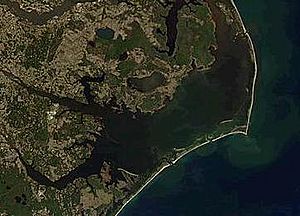Pamlico Sound facts for kids
Pamlico Sound (PAM-lik-oh) is a large body of water in North Carolina, USA. It is the biggest lagoon along the East Coast of the United States. A lagoon is a shallow body of water separated from the ocean by a narrow strip of land.
Pamlico Sound is about 80 miles (129 km) long and 15 to 20 miles (24 to 32 km) wide. It is part of a huge network of connected lagoons. This network includes Albemarle Sound, Currituck Sound, Croatan Sound, Bogue Sound, Core Sound, and Roanoke Sound. Together, these waters are called the Albemarle-Pamlico sound system. It is the second largest estuary in the United States, covering over 3,000 square miles (7,800 km2) of open water. (An estuary is where a river meets the sea, mixing fresh and salt water.) The Chesapeake Bay is the largest estuary in the US.
The Outer Banks separate Pamlico Sound from the Atlantic Ocean. The Outer Banks are a line of low, sandy barrier islands. These islands include places like Cape Hatteras National Seashore and Cape Lookout National Seashore. The Albemarle-Pamlico Sound is one of 19 important waters recognized by America's Great Waters Coalition.
How Pamlico Sound Works
Pamlico Sound is connected to Albemarle Sound in the north through passages like Roanoke Sound and Croatan Sound. Core Sound is at the narrow southern end of Pamlico Sound.
Rivers like the Neuse River and Pamlico River (which is the estuary of the Tar River) flow into Pamlico Sound from the west. From the east, water flows in from the Atlantic Ocean through openings called Oregon Inlet, Hatteras Inlet, and Ocracoke Inlet.
The water in Pamlico Sound is salty, but not as salty as the ocean. Its saltiness (called salinity) is about 20 parts per thousand (ppt). The Atlantic Ocean is about 35 ppt, and the Currituck Sound (north of Albemarle Sound) is only about 3 ppt.
The sound and its ocean inlets have many shallow areas. These shallow spots, called shoals, can make it tricky for larger boats to navigate. The deepest part of the sound is about 26 feet (8 meters) deep. However, most of the sound is only about 5 to 6 feet (1.5 to 1.8 meters) deep.
Because the water is so shallow, its level can change a lot. Strong winds and changes in air pressure can cause the water to rise or fall. This effect is even bigger in the rivers that flow into the sound. Water levels there can change by as much as two feet in just three hours if the wind is blowing strongly in the right direction.
History and Fun Uses
In March 1524, an Italian explorer named Giovanni da Verrazzano saw Pamlico Sound. He thought it was the Pacific Ocean because it was so wide and separated from the Atlantic Ocean by the Outer Banks.
The sound was named after the Pamlico Native American tribe. This tribe lived along the mainland banks of the sound. The Raleigh expeditions in the late 1500s called them the Pamouik.
In 1987, the US Congress said the Albemarle-Pamlico Sound was an "estuary of national significance." This means it is very important to the country.
Today, Pamlico Sound is a popular place for fun water activities. Visitors to the Outer Banks enjoy fishing, crabbing, boating, kayaking, sailing, windsurfing, and paddleboarding. Tourism in the Albemarle-Pamlico Sound area brings in a lot of money, over $1.3 billion in 2012.
The sound is also very important for local fishing. About 90% of North Carolina's commercial fishing catches come from Pamlico Sound. This brings in almost $100 million each year. People catch fish, crabs, shrimp, clams, and oysters here.
Amazing Wildlife
Pamlico Sound is home to many different animals. Along the coast, there are many places where waterfowl (birds that live near water) build their nests. These include Pea Island National Wildlife Refuge on the Outer Banks and Swanquarter National Wildlife Refuge on the mainland.
You can often see dolphins and sea turtles in the sound. Sometimes, seals like harp seals visit in January and February. Other types of whales, like fin whales and humpback whales, have been seen off the Outer Banks and near Cape Hatteras. Rare and endangered animals like leatherback turtles, great white sharks, and basking sharks also visit the sound.
The sound is full of different kinds of fish, including red drum, speckled trout, flounder, and striped bass. Local people call striped bass "rockfish." You can also find croaker, spot, pompano, kingfish, and bluefish. The populations of shellfish like blue crabs, shrimp, oysters, and clams are also healthy here.
Gallery
-
A sunset on Pamlico Sound as seen from The Inn on Pamlico Sound in Buxton, North Carolina.
-
Sunset over the Sound just south of Salvo, North Carolina.
See also
 In Spanish: Pamlico Sound para niños
In Spanish: Pamlico Sound para niños




